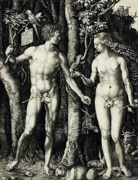

Examples of engravings:

Italy, XV century, after
Andrea Mantegna (Italian, 1430-1506), Bacchanal with a Wine Vat, c. 1490, engraving,
11 3/4 x 17 1/4 inches (29.8 x 43.8 cm), Metropolitan Museum
of Art, NY.
Antonio Pollaiuolo (Italian, 1431/2-1498), Nude Warriors in Combat (Battle of the Nudes), c. 1470-1475, engraving, 0.40 x 0.60 m, Louvre. See Gothic.

Martin Schongauer (German, c. 1445-1491),
Christ Carrying the Cross, c. 1475-80,
engraving, 11 3/8 x 16 7/8 inches (28.9 x 42.9 cm), Metropolitan
Museum of Art, NY.
Albrecht Dürer (German, 1471-1528), The Walk, c. 1496-1498, 195 x 120 cm, engraving, Hermitage Museum, St. Petersburg, Russia.

Albrecht Dürer, Adam and Eve, 1504, engraving, 9 3/4 x 7 1/2 inches (24.8 x 19.1 cm), Los Angeles County Museum of Art.

Marcantonio Raimondi, after Raphael, The
Judgment of Paris, c. 1517-20, engraving, 11 5/8 x 17
1/4 inches (29.5 x 43.8 cm) clipped impression, plate line, Metropolitan
Museum of Art, NY.
Claude Mellan (French, 1598-1688)

Robert Nanteuil (French, 1623-1678), Le Maréchal de Castelnau, 1658,
engraving, feigned oval,
U of Michigan Museum of Art, Ann Arbor, MI. Nanteuil was the
official engraver of portraits for King Louis XIV. The excellence
of his engravings' craftsmanship
has never been surpassed.

Robert Nanteuil, Saint-Brisson (Pierre Séguier, Marquis
de), 1659, engraving, U of Michigan Museum of Art, Ann
Arbor, MI.
Robert Nanteuil, Louis Phélipeaux de Lavrilliére, 1662, plate 26.2 x 33 cm, picture 25.8 x 32.5 cm, sheet 27.2 x 35.4 cm, Finnish National Gallery, Helsinki.

Robert Nanteuil, Portrait of Louis XIV, 17th century,
engraving, 49.7 x 42.6 cm (image) inches, Fine Arts Museums
of San Francisco, CA. Detail of an eye.
Antoine Masson (French, 1636-1700)
Maria Sibylla Merian, (German, 1647-1717), Plate 1 from Dissertation in Insect Generations and Metamorphosis in Surinam, second edition, 1719, hand-colored engraving on paper, 12 3/4 x 9 3/4 inches, National Museum of Women in the Arts, Washington, DC.
Pierre Drevet (engraver) (French, 1663-1738)
William Hogarth (1697-1764), after his paintings, and engraved by others, "Marriage a la Mode," 1745, engravings on paper, each with a width of 47 cm:
Plate I. The impoverished Lord Squanderfield has arranged a marriage between his son and the daughter of a wealthy alderman and merchant. Lord Squanderfield points to his family tree to emphasize his noble lineage. On the opposite side of the room his son sits taking snuff and looking with vanity into an adjacent mirror.
Plate II. The young nobleman comes home from a night of revelry at 1:20 am and ignores his wife who has been holding a card party. The steward walks out in disgust.
Plate III. The nobleman is in the house of Dr. Misaubin, 96 St. Martin's Lane. He threatens the quack with his cane for having prescribed pills which proved ineffective in curing a girl he has debauched.
Plate IV. The wife is in her boudoir talking with counsellor Silvertongue. She is now a countess and a mother but she is neglecting her child. A barber dresses her hair and a singer entertains. Symbols of extravagance are strewn all around. This is the second state of the plate. See satire.
William Blake (English, 1757-1827), And my Servant Job shall pray for you, 1825, engraving, image size: 213 x 168 mm, (94 k image,) Spencer Museum of Art, KS. Click here for a 60 k image.
William Blake, There were not found Women fair as the Daughters of Job, 1825, engraving, image size: 212 x 165 mm, (157 k image,) Spencer Museum of Art, KS. Click here for a 79 k image.
![]()
Germany, Prussia, 5 Talers [denomination], treasury-bill,
1856, engraving, Münzkabinett, Berlin. See numismatics.
Emile Gallé (French, 1846-1904), Dragonfly Coupe, La Libellule, layered, inlaid, blown, and trailed glass, internal metal-foil decoration, cut, engraved, height 18.3 cm, Corning Museum of Glass, NY.

Pieter Dupont (Dutch, 1870-1911), Steinlen, 1901, engraving. Dupont contributed to a brief European revival of engraving. This is a portrait of the graphic artist, Théophile Alexandre Steinlen (Swiss, 1859-1932).

United States of America, One Dollar Federal Reserve Note, 1988, recto and verso, engraving on paper (a
cotton and linen blend, with red and blue minute silk fibers running
through it), 2 5/8 x 6 inches. This design is similar to all one dollar bills produced from 1957-present. See articles about symbolism on the one dollar Federal Reserve Note, recto, and verso.
The term 'engraving' is too often confused with that of etching.
Also see bookplate, burin, drypoint, edition, exonumia, gravure, impression, moiré, ox gall, paper, philately, photogravure, and plaque.
https://inform.quest/_art
Copyright © 1996-![]()